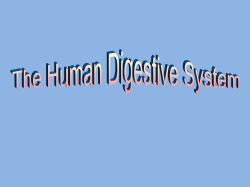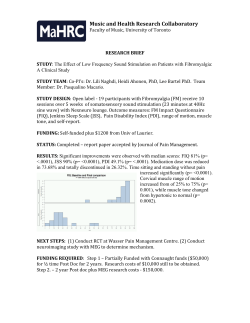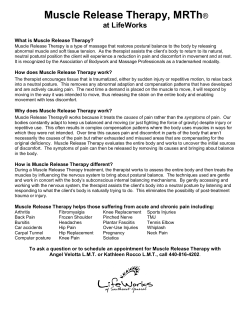
Gastrointestinal Physiology (1)
Gastrointestinal Physiology Dr. Mohammed Alzoghaibi 1 Dr. Alzoghaibi The Role of GIT Provides the body with water, electrolytes and nutrients Requires: 1. 2. 3. 4. 5. 2 Movement of food Break down the food to absorbable materials Digestion of food by different juices Absorption of digestive materials Neural control Dr. Alzoghaibi 3 Dr. Alzoghaibi SMOOTH MUSCLE OF G.I. TWO SMOOTH MUSCLE CLASSIFICATIONS Unitary type - Contract spontaneously in the absence of neural or hormonal influence but in response to stretch (such as in stomach and intestine) - Cells are electrically coupled via gap junctions Multiunit type - Do not contract in response to stretch or without neural input (such as in esophagus & gall bladder) 4 Dr. Alzoghaibi SMOOTH MUSCLE OF G.I. Phasic contractions - periodic contractions followed by relaxation; such as in gastric antrum, small intestine and esophagus Tonic contractions - maintained contraction without relaxation; such as in orad region of the stomach, lower esoghageal, ileocecal and internal anal sphincter - not associated with slow waves 5 Dr. Alzoghaibi SMOOTH MUSCLE OF G.I. Tonic contractions (continued): - Caused by: • Continuous repetitive spike potential • Hormonal effects • Continuous entery of Ca 6 Dr. Alzoghaibi The Musculature of the Digestive Tract Two main muscle layers: Longitudinal muscle layer Circular muscle layer Oblique muscle layer (stomach only) 7 Dr. Alzoghaibi The Musculature of the Digestive Tract 8 Longitudinal Muscle: Contraction shortens the segment of the intestine and expands the lumen Innervated by ENS, mainly by excitatory motor neuron Ca influx from out side is important Dr. Alzoghaibi The Musculature of the Digestive Tract Circular muscle: Thicker and more powerful than longitudinal Contraction reduces the diameter of the lumen and increases its length Innervated by ENS, both excitatory and inhibitory motor neurons More gap junctions than in longitudinal muscle Intracellular release of Ca is more important 9 Dr. Alzoghaibi 10 Dr. Alzoghaibi 11 Dr. Alzoghaibi 12 Dr. Alzoghaibi 13 Dr. Alzoghaibi Electromechanical & Pharmacomechanical Coupling Trigger Contractions in GI Muscles Depolarization opens the voltage-gated Ca channels (electromechanical coupling) Ligands open the ligand-gated Ca channels (pharmacomechanical coupling) 14 Dr. Alzoghaibi Gastrointestinal Peptides 15 Hormones - endocrine cells - via portal circulation and liver - e.g., gastrin, CCK, secretin and GIP Paracrines - endocrine cells - thru diffusion at the same tissue - e.g., somatostatin (mucosa), to inhibit gastric H secretion Neurocrines - neuronal cells in GI tract - e.g., VIP, GRP and Enkephalins Dr. Alzoghaibi Slow Waves & Action potentials are Forms of Electrical Activity in GI Muscles Slow waves - Unknown cause - Responsible for triggering AP in G.I. - Interstitial cells of Cajal, ICCs (pacemaker) Myenteric border Submucosa border - Occur at different frequency stomach (3/min) small intestine (duodenum, 12-18/min) ileum & colon (6-10/min) - May or may not accompanied by AP 16 Dr. Alzoghaibi 17 Dr. Alzoghaibi 18 Dr. Alzoghaibi Slow Waves & Action potentials are Forms of Electrical Activity in GI Muscles Factors that depolarize the membrane: Stretching of the muscle Ach Parasympathetic stimulation Hormonal stimulation Factors that hyperpolarize the membrane: Norepinephrine Sympathetic stimulation 19 Dr. Alzoghaibi CONTROL OF DIGESTIVE FUNCTIONS BY NERVOUS SYSTEM Autonomic nervous system (ANS) is divided into - Parasympathetic - Sympathetic - ENS 20 Dr. Alzoghaibi CONTROL OF DIGESTIVE FUNCTIONS BY NERVOUS SYSTEM Parasympathetic 21 Nerves: Located in brain stem & sacral region Projection to the G.I. are preganglionic efferents Vagus & pelvic nerves Vagus nerves synapse with neurons of ENS in esophagus, stomach, small intestine, colon, gall bladder & pancreas Pelvic nerves synapse with ENS in large intestine Neurotransmitter is Ach Dr. Alzoghaibi CONTROL OF DIGESTIVE FUNCTIONS BY NERVOUS SYSTEM Sympathetic 22 nerves: Located in thoracic & lumbar regions Neurotransmitter is NE NE increases sphincter tension Inactivate the motility Dr. Alzoghaibi 23 Dr. Alzoghaibi CONTROL OF DIGESTIVE FUNCTIONS BY NERVOUS SYSTEM Enteric Nervous System (minibrain) Has as many neurons as spinal cord 24 Located close to the effector systems such as: - Musculature - Glands - Blood vessels (from esophagus to the anus) Consists of ganglia & fibers projecting to the effector systems Dr. Alzoghaibi CONTROL OF DIGESTIVE FUNCTIONS BY NERVOUS SYSTEM Enteric Nervous System (minibrain) Composes of two plexuses: 1- myenteric plexus: excitatory or inhibitory (outer plexus) - increases intensity of rhythm of contraction - increases tone - increases rhythm rate - increases velocity of conduction of excitatory waves 2- Submucous plexus (inner plexus) 25 Dr. Alzoghaibi 26 Dr. Alzoghaibi 27 Dr. Alzoghaibi Excitatory Motor Neurons Evoke Muscle Contraction & Intestinal Secretion 1. 2. 1. 2. 3. 28 Neurotransmitters of motor neurons: Substance P Ach Neurotransmitters of secretomotor neurons (releasing of water, electrolytes and mucus from crypts of Lieberkuhn): Ach VIP Histamine (neurogenic secretory diarrhea) Dr. Alzoghaibi Inhibitory Motor Neurons Suppress Muscle Contraction 1. 2. 3. Neurotransmitters: ATP NO VIP N.B. Longitudinal muscles do not have inhibitory motor innervation 29 Dr. Alzoghaibi 30 Dr. Alzoghaibi 31 Dr. Alzoghaibi 32 Dr. Alzoghaibi 33 Dr. Alzoghaibi
© Copyright 2025













